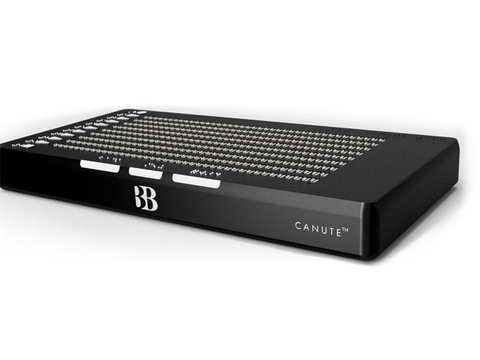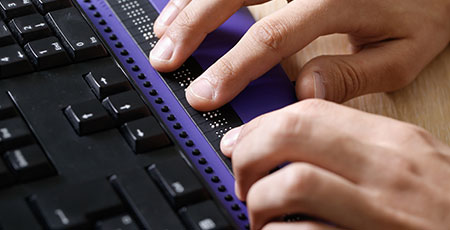Smart Glasses for the Visually Impaired: Breakthroughs in Vision Support
Wiki Article
Discover Cutting-edge Tools Created for the Visually Impaired
The advancement of cutting-edge devices for the aesthetically impaired stands for a substantial advancement in availability and freedom. Technologies such as clever glasses with AI capacities and mobile applications created to supply acoustic summaries are reshaping day-to-day experiences for users. Furthermore, wearable gadgets that employ haptic feedback improve ecological understanding, while contemporary Braille technologies use brand-new ways to involve with text. As these devices proceed to evolve, their effect on the lives of those with visual impairments elevates important inquiries concerning the future of inclusivity and autonomy in various elements of life. What lies in advance in this technological landscape?Smart Glasses for Navigating

Smart glasses made for navigating are revolutionizing the means visually damaged individuals interact with their setting. These innovative tools use a mix of cam technology, expert system, and acoustic responses to supply real-time information regarding surroundings. By employing obstacle detection systems, smart glasses can signal individuals to prospective dangers, making it possible for much safer mobility in both strange and familiar settings.
The integration of GPS modern technology better boosts navigation abilities, enabling users to get acoustic directions as they move. This hands-free method not just cultivates self-reliance however likewise encourages visually damaged individuals to browse city landscapes with enhanced self-confidence. Furthermore, lots of wise glasses are furnished with attributes that identify spots and street indications, supplying contextual info that boosts the individual experience.
Moreover, the development of these devices is constantly advancing, with business working to enhance the accuracy of item recognition and broaden the array of navigational functions. As wise glasses come to be extra easily accessible and economical, they hold the possible to considerably change daily life for aesthetically damaged customers. Eventually, these ingenious devices represent a vital action towards inclusivity, offering improved movement and a higher feeling of freedom for individuals navigating the globe around them.

Mobile Application for Daily Living
Exactly how can mobile applications improve the every day lives of aesthetically impaired people? Mobile applications are reinventing the means visually impaired individuals navigate their environments, handle day-to-day jobs, and gain access to details. These applications offer important support with different performances, fostering independence and enhancing high quality of life.Numerous ingenious mobile applications are designed particularly for day-to-day living. Applications like Be My Eyes connect aesthetically damaged customers with sighted volunteers by means of video telephone calls, enabling them to obtain real-time support with tasks such as checking out tags or browsing unknown rooms. Similarly, Seeing AI, developed by Microsoft, utilizes synthetic knowledge to describe surroundings, checked out text, and identify items, efficiently transforming a mobile phone right into a powerful device for day-to-day help.
Additionally, navigation apps customized for the visually impaired, such as Aira and BlindSquare, supply audio-based instructions and environmental information, allowing individuals to traverse their surroundings securely and confidently. Past navigating and instant assistance, mobile applications also sustain organization and task monitoring, with functions that aid users set suggestions, develop order of business, and track appointments. In summary, mobile applications function as essential sources, encouraging aesthetically damaged people to lead even more independent and fulfilling lives.
Wearable Technologies for Support
Empowerment through modern technology is increasingly noticeable in the world of wearable gadgets developed to help visually impaired people. These innovative devices incorporate seamlessly into day-to-day live, boosting navigating and giving crucial feedback to customers. For example, smart glasses furnished with video cameras can read and recognize faces message aloud, permitting users to connect even more confidently in expert and social setups.An additional notable development is the use of haptic responses systems in wearable tools. These systems utilize vibrations or various other responsive signals to share details about the individual's atmosphere, such as obstacles or adjustments in surface, boosting wheelchair and safety. Wearable technologies also consist of wristbands that connect to smartphones, notifying customers to notifications through subtle vibrations, therefore improving connectivity without reliance on visual hints.
As these innovations continue to advance, they are not just boosting independence for aesthetically impaired individuals however also cultivating a better sense of addition in society. By bridging the gap in between difficulties faced in everyday living and the possibility for freedom, wearable innovations offer as pivotal devices in the mission for equality and empowerment for those with visual disabilities.
Audio Summary Devices
Sound summary tools play a critical role in boosting availability for aesthetically damaged individuals, providing them with the capability to engage with visual media. Wearable technology for low vision. These devices supply narrated descriptions of vital review aesthetic components in movies, television shows, and live performances, making sure that users can fully understand the context and emotions communicated through visualsSound description can be integrated right into different platforms, consisting of streaming services, movie theater testings, and live cinema. like this Numerous preferred streaming solutions currently consist of audio description as an accessibility feature, enabling visitors to select it easily. In enhancement to mainstream media, specialized apps additionally exist, offering audio summaries for art exhibits, museums, and various other social events.
The effectiveness of audio description depends upon the skill of the narrators, that must share aesthetic information succinctly without diminishing the original audio. Innovations in this field are likewise leading the way for more customized experiences, where users can readjust the degree of detail and pacing according to their choices.
Braille Innovations and Devices
Braille devices and technologies have actually dramatically changed the way aesthetically damaged people connect with text and details. Modern advancements have led to the development of versatile tools that enhance literacy and freedom among users.
Additionally, portable Braille notetakers incorporate traditional Braille input with modern functionalities, assisting in note-taking, organizing, and document editing on the move. Assistive technology for the blind. These compact tools frequently include text-to-speech capacities, connecting best color blind glasses the space in between Braille and auditory information
Additionally, innovative Braille printers have actually emerged, allowing individuals to generate Braille tags, files, and educational materials effectively. This ease of access fosters better involvement in educational and specialist atmospheres, ultimately advertising inclusivity.
Additionally, study into smart Braille innovations continues to increase. Tools that incorporate synthetic intelligence are being explored to give real-time navigating aid and contextual info, enhancing the individual experience in diverse settings. Overall, these technologies mirror a commitment to equipping visually damaged individuals with technology, guaranteeing they can conveniently access and involve with the world around them.
.png)
Verdict
The innovation of innovative tools for the aesthetically damaged dramatically boosts independence and top quality of life. These modern technologies not only foster higher addition however also promote autonomy in daily activities, inevitably adding to a more obtainable and fair culture for visually impaired people.As wise glasses end up being much more cost effective and obtainable, they hold the potential to significantly change everyday life for visually impaired customers. Mobile apps are revolutionizing the way visually impaired users navigate their settings, take care of daily jobs, and accessibility information. Apps like Be My Eyes link aesthetically damaged individuals with sighted volunteers using video clip telephone calls, permitting them to obtain real-time assistance with jobs such as reading labels or navigating unknown rooms.Furthermore, navigation apps tailored for the visually damaged, such as Aira and BlindSquare, offer audio-based instructions and environmental info, allowing individuals to traverse their environments safely and confidently.The development of innovative tools for the aesthetically impaired dramatically enhances independence and high quality of life.
Report this wiki page